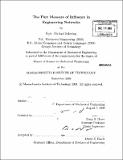The flux measure of influence in engineering networks
Author(s)
Schwing, Kyle Michael
DownloadFull printable version (11.03Mb)
Other Contributors
Massachusetts Institute of Technology. Dept. of Mechanical Engineering.
Advisor
Franz S. Hover.
Terms of use
Metadata
Show full item recordAbstract
The objective of this project is to characterize the influence of individual nodes in complex networks. The flux metric developed here achieves this goal by considering the difference between the weighted outdegree and indegree of a node. This technique differentiates among nodes that traditional centrality measures treat as identical units. The behavior and proper interpretation of the flux metric are demonstrated on a variety of weighted and directed networks. Simulations of fluid flow, opinion sharing, epidemic dynamics, and resource allocation reveal the practical capabilities of the flux metric. An engineering design challenge may also be framed as a network analysis problem so that the the flux metric contributes to understanding the relationships among the system's subcomponents and objectives. A case study that investigates the design of autonomous underwater vehicles (AUVs) for use in the offshore oil and gas industry demonstrates these insights. In all of the applications explored here, the flux metric consistently emerges as a reliable indicator of the influence of a node.
Description
Thesis (S.M.)--Massachusetts Institute of Technology, Dept. of Mechanical Engineering, 2009. Cataloged from PDF version of thesis. Includes bibliographical references (p. 109-115).
Date issued
2009Department
Massachusetts Institute of Technology. Department of Mechanical EngineeringPublisher
Massachusetts Institute of Technology
Keywords
Mechanical Engineering.